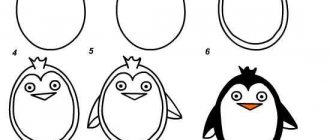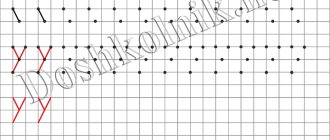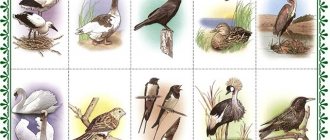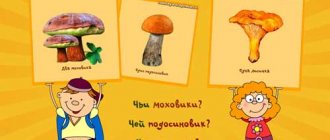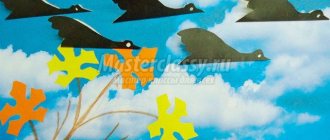Summary of a lesson on speech development on the topic: “Birds of passage”
STATE BUDGETARY EDUCATIONAL INSTITUTION OF THE CITY OF MOSCOW "Center for Education and Sports "Moscow-98" of the Department of Sports and Tourism of the City of Moscow GBOU "TsOiS "Moscow-98" Moskomsport _______________________________________________________________________________ 110607, Moscow, Udaltsova, no. 40 t.
(499) 432-39- 01 e- mail : s [email protected] mossport . ru
LESSON SUMMARY ON SPEECH DEVELOPMENT ON THE TOPIC:
" MIGRATORY BIRDS "
(for children with STD in the preparatory group)
Prepared by teacher - speech therapist Elena Vladimirovna Neklyudova
Topic: "Migratory birds"
Goal: to consolidate the skill of writing descriptive stories, Objectives:
Educational
: - to develop the skill of children working with a diagram - the basis of a descriptive story, - to teach children to compose a descriptive story based on the basis diagram
Corrective-developmental:
- to expand the vocabulary on the topic, - to highlight the main positions necessary for composing a descriptive story - to develop logical thinking and memory, - to develop auditory and visual attention.
Educational:
- increase children’s activity in class.
Equipment:
subject pictures with images of migratory birds, a demonstration diagram - the basis for compiling a descriptive story about a migratory bird (T.A. Tkachenko’s method), sectional pictures, riddles about migratory birds.
H o d a n i a t i i
I.Organizational moment:
Speech therapist teacher:
-
Hello, guys! Tell me, what time of year is it now? What signs of spring do you know? (children's answers).
II . Main part of the lesson
1) Setting the goal of the lesson
Speech therapist teacher:
-
Today we will talk about migratory birds; about where the name “migratory birds” came from; look at the pictures; Let's read and guess riddles about these birds.
2) Expanding the vocabulary on the topic
Teacher speech therapist: —
So, today we will talk about migratory birds.
Guys, why do you think they are called migratory?
(children's answers).
Migratory birds
leave their native places in the fall and fly to warmer climes.
They return home with the onset of spring. Look at the pictures, do you know what these birds are called? (children's answers). The speech therapist teacher
displays a poster on the board that depicts three birds: a starling, a swallow and a rook.
The speech therapist invites the children to name these birds and once again draws the children’s attention to the fact that these are migratory birds.
The speech therapist invites children to name and show the body parts of birds: head, beak, torso, two wings, two legs (paws) and tail.
The legs (paws) of birds are covered with durable skin, they have three “toes” in front, and another one behind, so they stand better on the ground. The tips of the “fingers” have sharp claws; they help birds cling to tree branches and rake grass to get food. The body of all birds is covered with feathers. The speech therapist asks the children why birds have wings. Yes, birds can fly with the help of their wings. The speech therapist draws the children's attention to the fact that these birds are different in size, color, etc. The largest bird on the poster is the ROOK, a slightly smaller one is the STARLING, and even smaller is the SWALLOW. Speech therapist teacher:
- People have always looked forward to the coming of spring.
The return of migratory birds meant that the cold weather had receded and warm spring days were setting in. Starlings are the first to return to their native land, for which people thanked him and built a house for him - a NIGHTBOOK. There are many folk proverbs about migratory birds: - The starling has arrived, winter is over!
- The swallow brought spring on its wings! Teacher speech therapist :
- Guys, tell me, what do the birds do when they return home? What are their concerns? (children's answers). That's right, they repair old nests or build new ones. After all, very soon eggs will appear in the nest, and then chicks will hatch from them.
- Do you know what birds build nests from? That's right, most birds build their nests out of twigs. To make it softer, they put dry grass and sometimes their own feathers at the bottom. People build a house only for the starling, and this house is called a birdhouse.
The swallow is building his house out of clay. She brings clay in her beak, and gradually her house takes the shape of an oval, which is fixed under the roof of a person’s house (the speech therapist shows a picture).
3) Development of attention, memory and logical thinking
Speech therapist teacher:
-
Guys, do you like to solve riddles? Then listen carefully, because every word is important in the riddle.
ON THE SIXTH IS A PALACE, ALL THE MIGRATION BIRDS ARE BLACK, IN THE PALACE IS A SINGER, HE CLEANS THE ARRANGE OF WORMS AND HIS NAME IS ………………. (rook
) (
starling
) HE SINGS AMONGST THE BRANCHES IN FRONT IS SCHILZE, SOUNDS CLEAR ……………….. BEHIND IS WILZE.
(nightingale) ( swallow)
A BIRD SITTED ON A BITCH OF FROGS I CATCH IN THE RIVER, AND SINGED A SONG: “KOO-KOO!” I AM STANDING ON ONE LEG. ( cuckoo) (heron)
4) PHYSICAL MINUTE - playing with a ball.
Speech therapist teacher:
-
Guys, do you know how to be attentive? Now I will ask questions and throw the ball to you, and you - if the question can be answered “YES” - catch the ball, if “NO” - don’t catch it. (For example; - Do birds have a beak? Are birds’ bodies covered with hair? Etc.)
5) Compiling descriptive stories - based on the diagram.
(according to T.A. Tkachenko’s method)
Speech therapist teacher:
- Guys, let's make up short stories about birds.
And a diagram will help us with this. This diagram reflects what needs to be said when describing a bird: - appearance
(parts of the body, color of feathers, size, etc.),
- wintering or migratory
(explain why),
- what is the name of its home
(nest, hollow) or birdhouse),
- what the bird eats
(insects, tree fruits, grain, etc.),
- whether it hatches chicks itself, - what benefits it brings to people.
Teacher speech therapist:
- Look at the pictures and let's make up stories:
This is SWALLOW -
small bird. She has a small head, a small beak. There are black wings on the head, wings, back and tail. There is a small red “spot” under the beak, and the swallow’s entire breast is white. The swallow is a migratory bird. The tail of a swallow looks like a fork. She builds herself a house out of clay. Her house looks like a big oval. The swallow feeds on small midges, mosquitoes and caterpillars. In the spring, the swallow lays eggs in the nest, and then “hatches” them, warming them with its warmth, after which chicks emerge from the eggs. Swallows, by eating insects, bring great benefits to humans.
This is GRACCH
- a large bird. The rook has a head, body, wings, tail and legs. The rook has a strong beak and strong legs. The rook is all black. This is a migratory bird. He builds his own nest from small sticks. The rook feeds on worms, caterpillars, beetle larvae, etc. In spring, rooks lay eggs and hatch chicks. By eating insects, the rook protects fields and gardens from harmful insects.
This is STARLING -
small bird. She has a head, a body, two wings, two legs and a tail. The starling has variegated feathers: most of the feathers are black, with yellowish speckles on the feathers. The starling is a migratory bird. Only for the starling do people build a house - a birdhouse. Starlings feed on a variety of insects. They lay eggs and hatch chicks. They benefit humans by destroying harmful insects.
If there is difficulty, the speech therapist helps the children with leading questions, drawing attention (showing) to what he forgot to tell.
6) Development of attention and visual correlation between part and whole - working with cut-out pictures
Teacher speech therapist
invites children to put together a picture from fragments (children put together cut pictures and name the bird).
In case of difficulty, the speech therapist helps the child.
III . Lesson summary
Teacher-speech therapist :
-
Guys, today we talked about migratory birds, looked at pictures, guessed riddles, and made up stories. Everyone tried very hard. Well done! The lesson is over.
Summary of an open lesson in a preparatory speech therapy group on the topic “Migratory Birds”
Goal : generalize children's knowledge about migratory birds.
OO tasks:
NGO “Cognitive Development” Expand and enrich children’s knowledge about migratory birds and their nesting characteristics; develop and consolidate rules of behavior in nature.
NGO “Social and Communicative Development” To develop the ability to work together, to cultivate an attentive and caring attitude towards living things (birds).
OO “Physical Development” Strengthen the ability to act on a signal. Ensure maximum physical activity during educational activities (carrying out actions according to instructions).
OO “Speech Development” Develop coherent speech on the topic, improve sound pronunciation and grammatical structure (inflection, use of prepositional-case forms). Replenish the nominative (names of migratory birds: stork, thrush, lark, swallow, warbler, wagtail, rook, starling, chaffinch, robin, warbler, wheatear) and predicative (sing, fly, curl, hatch, hatch, build, peck) children's vocabulary .
NGO “Artistic and Aesthetic Development” To develop an interest in music in nature through listening to recordings of bird voices.
Preliminary work : conversations showing illustrations of migratory birds and familiarization with the features of their nesting; reading fiction on the topic, becoming familiar with the rules of behavior in nature.
Equipment : recording of birdsong, 2 easels, pointer, ball, diagrams “Change the word”, “Where is the object?”, inscriptions of the names of birds, divided into two parts; signs for physical minutes: “Park”, “Street”, “Birch”, “Glade”, “Fields”; box with branches, leaves, dry grass, straw, stones, feathers, moss, clay.
Progress:
1. Organizational moment.
Children in a circle on the carpet. The sound of birds singing. P.: Guys, what is this? D: The birds are singing. P: Why do they sing? D.: Because spring came, it became warm, and the birds returned to their native lands. P: Right, but why did the birds return now, in the spring? D.: Because insects appear and the birds will have food. P: Guys, what migratory birds do you know? Children's answers. P.: Guys, today Vanya brought an interesting box to kindergarten, let's look into it! Children and their teacher look at the contents of the box. P.: Who will need all this? D.: Birds! P.: That’s right, but we will find out exactly how during our conversation.
2. D/games “Change the word.”
P.: To distribute the contents of the box to the birds, we will practice changing the names of the birds. Children (2-3 people) change the word by case, following the pattern: for example, there is a nightingale, there is no nightingale, I go to the nightingale, I see the nightingale, I think about the nightingale, I admire the nightingale. P.: Well done, let's play again? Children stand in a circle on the carpet. P.: Catch the ball and answer, Answer and don’t yawn! What can a bird do?
3. D/game “What can a bird do?”
D.: flies, sings, howls, hatches, lays, hatches, builds, lines, insulates, pecks, jumps, etc.
4. D/exercise "Where is the bird?"
P.: Let's play with the starling and his house - what is it called? D.: Birdhouse. P.: Name where the starling is relative to the birdhouse, the rook relative to the nest, using our diagram: P.: Are you probably tired? And so everyone stood up! What birds are called the harbingers of spring? D.: Rooks. P.: We turn into rooks and “fly” around the group, reading the signs and listening to my instructions.
5. Phys. just a minute.
There are signs hanging around the group: Park, Street, Birch, Glade, Fields. The teacher guides the children by saying phrases, and the children follow the route and follow the instructions:
- In early spring, the rooks returned to the Park.
- The Street became noisy from the loud cry of the rooks - “rook!, rook!”
- At the top of the Birch, rooks are repairing last year's nests.
- In the spacious Glade, rooks and rooks collect dry grass to line their nests.
- In the plowed fields, rooks collect beetles, larvae, and worms.
P.: We rested, flew around and collected the names of the birds into words.
6. D/exercise “Put the word together.”
Look, on the easels there is the beginning of the word and the end, you collect the parts of the word, and read the name of the bird. Children approach the easels and put the syllables into words: Pe - night, a - ist, ka - menka, shake - tail, mal - new, zhavo - ronok, slav - ka, chill - face, las - dot, squaw - retz. P.: What birds flew to us? Children read the resulting words. P.: It’s time to help the birds, let’s look at the box and give each bird something that will be useful for building a nest.
7. D/game “Who needs a gift?”
Children take out one object each and “distribute” it to the birds, explaining their choice: Stones - to the wheatear, clay - to the swallow, branches - to the stork, feathers - to the warbler, grass, straw - to the lark, warbler, moss - to the chaffinch, leaves - to the starling, robin, wagtail .
8. Results.
The sound of birds singing. Children are sitting on the carpet. P: How joyfully the birds sing! Tell me, what are they happy about? D.: They returned to their nests, they have everything to repair and build their homes. P.: That’s right, the birds thank you, guys, and are always happy to see you in forests, parks, squares, you just need to remember the rules of behavior. Do you know them? D.: You cannot make noise, shout, tear leaves, flowers, break branches, destroy nests, etc. P.: You are right, and our journey with the birds has come to an end, well done!
Ivanova Anna Vladimirovna Teacher-speech therapist, MDOU "Kindergarten No. 176", Yaroslavl

